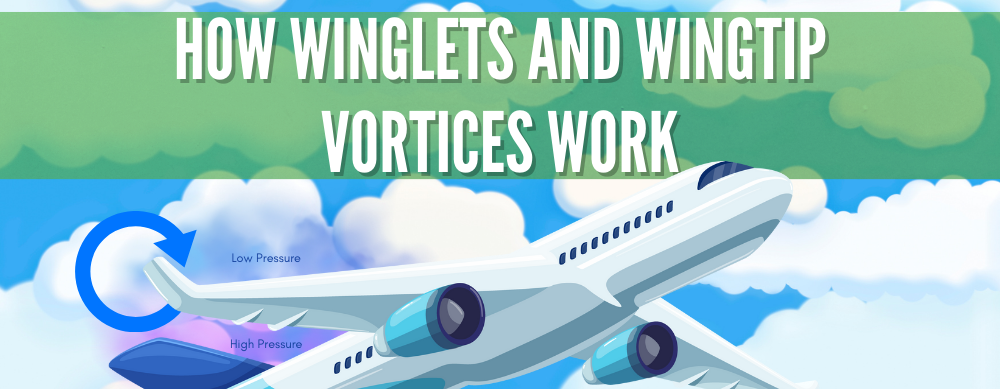Cómo funcionan los winglets y los vórtices de las puntas de las alas
¿Tienes curiosidad por los vórtices en las puntas de las alas y cómo funcionan? Son espirales de aire causadas por diferencias de presión en el ala de un avión, que crean una resistencia inducida que afecta el rendimiento. Los winglets, esas extensiones en ángulo en las puntas de las alas, ayudan a reducir estos vórtices y aumentan la eficiencia.
¡Vamos a sumergirnos en los detalles!

¿Te preguntas qué son los vórtices de las puntas de las alas y cómo funcionan? Tenemos la respuesta para ti. Los vórtices de las puntas de las alas son espirales de aire creadas por la diferencia de presión entre las superficies superior e inferior del ala de un avión.
Esto genera una resistencia inducida que reduce el rendimiento del avión. Los winglets son extensiones verticales o en ángulo en las puntas de las alas y están diseñados para mitigar estos vórtices, lo que puede ayudar a mejorar el rendimiento.
En este artículo exploraremos y responderemos todo lo que quieras saber sobre este tema.
¡Empecemos!
RESUMEN
-
Los vórtices en las puntas de las alas son el resultado del aire a alta presión que se derrama alrededor de las puntas de las alas, lo que crea resistencia.
-
Los winglets funcionan interrumpiendo este flujo de aire, reduciendo la resistencia inducida y mejorando la aerodinámica.
-
Las alas de alta relación de aspecto u otras alternativas de diseño también pueden minimizar los efectos de los vórtices en las puntas de las alas.
-
Los winglets mejoran el rendimiento del combustible, pero no siempre son la mejor opción para todas las aeronaves.

¿Qué son los vórtices de punta de ala?
Los vórtices en las puntas de las alas son columnas de aire en espiral que se crean en las puntas de las alas de un avión. Se forman debido a la diferencia de presión entre las superficies superior e inferior del ala.
El aire de alta presión que se encuentra debajo del ala intenta naturalmente moverse hacia la región de baja presión que se encuentra arriba, derramándose alrededor de las puntas del ala y girando en espiral hacia adentro.
Este movimiento en espiral crea un vórtice, como un mini tornado, que se desplaza detrás del avión. Si bien los vórtices se disipan con el tiempo, representan energía desperdiciada, que se manifiesta como resistencia inducida.
¿Por qué los vórtices en las puntas de las alas generan resistencia?
La sustentación que genera un ala suele ser perpendicular al flujo de aire, o viento relativo, y ayuda a la aeronave a ascender o mantener la altitud.
Sin embargo, los vórtices en las puntas de las alas desvían el viento relativo hacia abajo cerca de las puntas de las alas, inclinando el vector de sustentación ligeramente hacia atrás.
Esta inclinación hacia atrás crea una resistencia inducida, que reduce la eficiencia de la aeronave y requiere más potencia del motor para mantener la velocidad o la altitud.

¿Cómo funcionan los winglets?
Las aletas son pequeñas extensiones verticales o en ángulo que se encuentran en los extremos de las alas y que están diseñadas específicamente para contrarrestar los efectos de los vórtices en las puntas de las alas. Así es como lo hacen:
-
Cambio de la dirección del flujo: los winglets modifican el viento relativo en la punta del ala. El vórtice se curva naturalmente hacia arriba y hacia adentro, doblando el flujo de aire. Al redirigir el flujo de aire, el winglet crea su propia sustentación.
-
Generación de sustentación hacia adelante: la sustentación generada por el winglet apunta ligeramente hacia adelante, lo que ayuda a contrarrestar la resistencia inducida. Esto sucede porque la sustentación del winglet está en ángulo en la misma dirección que el movimiento hacia adelante del avión.
-
Mejora de la eficiencia: al mitigar la pérdida de energía por la resistencia inducida, los winglets mejoran el uso de combustible, el alcance y el rendimiento de ascenso.

Cómo los winglets reducen la resistencia
Los winglets reducen la resistencia aerodinámica al controlar el aire que se arremolina en las puntas de las alas, llamados vórtices de las puntas de las alas. Estos vórtices se forman porque el aire de alta presión que se encuentra debajo de las alas se derrama hacia la zona de baja presión que se encuentra por encima, creando una espiral de aire que se arrastra detrás del avión. Esta espiral arrastra al avión hacia abajo, convirtiendo literalmente parte de su sustentación en resistencia aerodinámica.
Aquí es donde entran en juego los winglets. Son esas extensiones en ángulo ascendente en las puntas de las alas, y funcionan como minialas. Al redirigir el flujo de aire en las puntas, los winglets interrumpen el vórtice y evitan que crezca con tanta fuerza.
No sólo reducen la resistencia causada por estos vórtices, sino que también generan un poco de sustentación adicional, ligeramente inclinada hacia adelante, lo que ayuda a que el avión se mueva de manera más eficiente.
¿El resultado? Menor consumo de combustible, mayor autonomía y mejor rendimiento.

¿Qué es un Winglet Combinado?
Los winglets combinados se conectan al ala con una curva suave en lugar de un ángulo agudo. Esto ayuda a reducir la fricción por interferencia en el punto de unión entre el ala y el winglet del avión.
Los ángulos pronunciados en esta zona pueden alterar el flujo de aire de la capa límite, lo que puede crear vórtices que generen resistencia y anulen algunos de los beneficios de los winglets. Al suavizar esta transición, los winglets combinados ayudan a proporcionar un mejor flujo de aire.
Las aletas cimitarra divididas son un diseño más avanzado desarrollado por Aviation Partners Boeing. Las aletas cimitarra divididas combinan los beneficios de las aletas combinadas con algunos ajustes aerodinámicos adicionales.
Estos ajustes incluyen un componente que apunta hacia abajo en el borde de salida, lo que ayuda a mejorar tanto la reducción de la resistencia como la eficiencia del combustible.
El papel de la relación de aspecto y el diseño del ala
Los winglets no son la única opción para mejorar el rendimiento aerodinámico. Existen alas con una relación de aspecto elevada, como las que tienen las puntas de las alas inclinadas, que también reducen la resistencia al aumentar la envergadura del ala.
Las alas delgadas con relaciones de aspecto más altas experimentan una menor resistencia inducida porque las puntas de las alas están más alejadas del área principal del ala, lo que puede reducir el impacto de los vórtices en las puntas de las alas.
La incorporación de winglets ofrece beneficios aerodinámicos similares sin necesidad de un ala más grande, lo que puede ser importante para la compatibilidad con los aeropuertos. Básicamente, los winglets son una opción popular tanto para los nuevos diseños de aeronaves como para los aviones comerciales reacondicionados.

¿Por qué no todos los aviones tienen winglets?
No todos los aviones están diseñados con winglets, y por una buena razón. Algunos aviones, como ciertos modelos del Boeing 777, utilizan diseños de alas alternativos para lograr beneficios aerodinámicos similares.
Por ejemplo, las alas de gran envergadura y alta relación de aspecto del 777 reducen naturalmente el impacto de los vórtices en las puntas de las alas, haciendo que los winglets sean innecesarios.
En otros casos, el peso adicional o la complejidad estructural de los winglets pueden ser mayores que sus beneficios, dependiendo de la misión de la aeronave y las limitaciones de diseño.

Preguntas frecuentes
-
¿Cómo reducen los winglets los vórtices en las puntas de las alas?
Los winglets interrumpen el flujo de aire alrededor de las puntas de las alas, debilitando la formación de vórtices y reduciendo así la resistencia inducida.
-
¿Cómo funcionan los vórtices en las puntas de las alas?
Los vórtices en las puntas de las alas se forman debido a las diferencias de presión en las superficies de las alas, lo que hace que el aire se desplace en espiral desde el área de alta presión debajo del ala hasta el área de baja presión arriba.
-
¿Cómo funcionan los winglets?
Los winglets se extienden desde las puntas de las alas para alterar los patrones de flujo de aire, disminuyendo la fuerza de los vórtices de las puntas de las alas y mejorando el rendimiento aerodinámico.
-
¿Por qué no hay winglets en algunos modelos del Boeing 777?
Algunos modelos de Boeing 777 cuentan con diseños de alas que reducen inherentemente la resistencia inducida, lo que hace innecesarios los winglets adicionales.
Llevar
Es importante aprender sobre la interacción entre los vórtices de las puntas de las alas y los winglets para apreciar cómo los aviones modernos funcionan mejor.
Los winglets sirven como una solución para reducir la resistencia inducida, y su implementación depende de varios factores, incluido el diseño del ala existente y los requisitos específicos de la aeronave.
¡Sigue aprendiendo más sobre aerodinámica y aumenta tus conocimientos de aviación!
¿Interesado en la aerodinámica?
¡Nuestras guías están diseñadas para ayudar!
-
Comprensión del principio de Bernoulli: conceptos clave explicados
-
Comba del perfil aerodinámico: su efecto sobre la aerodinámica Cómo genera sustentación
-
Cómo funcionan los planeadores: qué los mantiene en el aire (guía completa)
-
¿Cómo vuelan los helicópteros? (Explicación de la aerodinámica)
¿Le resultó útil este artículo?
¿Crees que nos hemos olvidado de alguna pregunta importante de la entrevista? ¡Cuéntanoslo en los comentarios a continuación!


